Interview, Stick Gets Grilled!!!/Review, Imagenomics Portraiture

|
• La Boutique Hotel Pierre Loti • Sheraton Istanbul Maslak Hotel • Radisson SAS Conference & Airport Hotel • Romantic Hotel Istanbul |
Thank you for your generous contributions. We're slowly collecting enough images to make the mosaics. I realize I'm posting the same paragraph each week, but I assure you we're on top of this project and doing our best to collect enough of the proper type of images to make the best possible set of mosaics. This is proving difficult so please help if you can.
We are still accepting (and pleading for) images of children from SEA. No matter how terrible you think they are, please send them in anyway. These images will be used to complete a set of 3 high quality mosaics which will be sold to benefit the Karen and Burmese Orphans living in the orphanages and refugee camps. The more images the better, I can use all you have. Please take the time to go through your images for anything you think might help. If you missed the "No Place to Call Home" special, you can click on the link and read more about this. Thank you! QandA@Bkkimages.com
Feature Photograph

1918, 18,000 Soldiers. Arthur S. Mole
I've never done this in the column before, but this week I'm running an image that came to me via email in one of those "pass it on or the world will end" deals. I looked at this image
and at first didn't see anything particularly interesting and then I read the bottom where it said 18,000 soldiers were used to form this image and all of a sudden I was interested!
Our countries have changed a lot since WWI (World War One) and I have to wonder if any country other than China or the DPRK (Democratic Republic of Korea (north)) could pull off using 18,000 soldiers to
promote anything in their country without the public getting upset over waste and abuse and calling for senate hearings. This one though might be something you really want to think about on many levels.
I was doubtful if this image was authentic so dug around on the internet, consulted Snopes, found like pictures at Hammer Gallery,
and found a really great history on these sorts of shots at the Iowa National Guard Museumsite. Folks, this image is real. It is as advertised. So what
is it?
This photo was taken by Mole & Thomas at Camp Dodge in July of 1918. The design (pay attention to the spatial perspective necessary to envision this shot) was laid out on the drill grounds using thousands of yards of white tape. 18,000 Officers and Enlisted filled the positions. The camera and photographers were up on a high tower and from the first to last man was over 1/4 of a mile. It's
especially interesting to note that there were 12,000 men used in the flame of the torch, twice as many as the number of men used in the rest of the image. This is part of the spatial perspective requirements necessary to pull this off.

A crop of the above image
It's also interesting to note, that even in 1918, hundred of these men were of foreign birth, standing side by side with native born citizens. Arthur S. Mole and John D. Thomas made several of these
types of images, for instance a Marine Corp emblem using 21,000 soldiers, and a human Liberty Bell using over 25,000! They used a 11×14 inch view camera. The negatives from these shots I'm sure are still in great shape today and beautiful.
I've seen 11×14" negatives and they're out of this world!
What would it take to pull off a similar feat in today's world? Would the public stand for using soldiers for such photographs? How about New York photographer Spencer Tunick's shot in Mexico City where 18,000 people got together
NUDE for a photograph? Tunick uses a Pentax 6×7 SLR and not a 11×14 view camera. Times and values have indeed changed. Personally I think Mole's & Thomas's work took
a lot more creativity both in the composition, and photographically. We should have learned more in over 90 years.

Linked from the above story
Interview, Stick Gets Grilled!!!
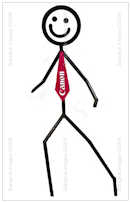
Everyone knows of' Stick, and some actually know the man behind the curtain. Any of his friends or family will testify he's not often without a camera close by. I've known him for years now and I've had a chance to observe his photography. 2-3 years ago he 'documented' more than he 'photographed' and this by itself is neither bad nor good. It's more of a style preference.
However, especially since moving up to his newest DSLR, the Canon 5d Mark II, he's started to lean more to the 'photograph' camp, becoming more concerned with composition and image quality. He's now paying attention to the details. Whether this growth, and yes I see it as growth, comes from necessity or interest doesn't matter. It matters that Stick is in the unique position with unique access to capture images and document the various nightlife venues few of us are. It matters that he derives great enjoyment from the process. It always has been, and always will be, all about having fun! Enjoy the interview.
BkkSteve: Stick, this is the interview the readers have been waiting for. We all know you're a camera buff and have enjoyed your images in your weekly and your galleries.
Can you tell us when you first started with photography?
Stick: I first started with photography when I left New Zealand to take off around Europe as a 20-year old. With me I had an Olympus 707 and one lens, a 35-70mm. I took about 500 shots over the 6 months I
spent in Europe, which is about what I shoot in one day nowadays if I go out with the express purpose of taking photos! Funnily enough, I never did use that camera again after that trip!

Auckland City at night. Canon 5d Mark II, 24-70mm, ISO 100 25 seconds @ F8.
BkkSteve: How long was it from the completion of your European stint, to the time you came to Thailand and decided to stay? What camera did you come to Thailand with?
Stick: When I returned to New Zealand I sort of forgot about photography. That was around late 1990. In late 1991, I think it was, I bought a Minolta Dynax 7Xi which reinvigorated my interest in photography.
Again, I only had one les, a 28 – 105 and I later bought a 50mm 1.7. I used that camera from then until when I came to Thailand.

My Home, Auckland City by day. Canon 5d Mark II, 24-70mm F2.8 @F7.1 1/160th ISO 100 with a Circular Polarizer.
BkkSteve: Okay, so you're in Thailand now and I'm guessing during this period you were teaching English? Was your interest in photography further motivated by the Thai countryside, or perhaps the
Thai people with street photography?
Stick: Actually, it was a little different to that. I simply got into photography this time around, which was late '99, with the advent of digital photography. I picked up a 2 megapixel basic Kodak digital
camera for the princely sum of 32,000 baht! It allowed me to take shots that I could use on the site. I was the first site at the time to start putting a lot of pretty photos online and it boosted the site's popularity a lot. It really was
not until I got a DSLR that my interest in different aspects of photography, such as street photography started to develop.

Wat Pho, Reclining Buddha. Kodak DC 280 1/15th @ F3, ISO 100.
BkkSteve: This is interesting, your path closely parallels my own. In 1998 I bought an Olympus C-3000 3.1mp point and shoot and I think it was over $1000 USD's with all the accessories I thought I needed!
Six months later I was in Thailand and knew I needed more from digital.
You mention your site and images. I'm sure I'm not the only one who looks forward to seeing what new images you post each week. Your style has developed heavily towards the street photography side, with a further emphasis on low light photography.
Was your first DSLR a good tool for this, or did it make you struggle?
Stick: My first DSLR was a Canon 20D. It was a great camera and I took approaching 30,000 shots with it and was very pleased with it. At night it was fine for taking basic shots of street scenes and the neon
from bars that I guess many associate with my images on this site. But for actually getting close up to people and shooting them, as good as it was it was limited.
1600 ISO just wasn't enough, even with the best lenses money could buy. I needed 4000 – 12800 ISO. If I went over 1600 ISO the 20D files started to show too much noise and the colours started to go, for want a better word, wonky.
A friend (wonder who that was!) allowed me the use of his 5D when we took a trip up country 2 1/2 years ago and when I shot at night and saw the quality of the RAW files I knew I had to go full frame.

Pretty girl on Soi Cowboy. Canon 20d, 24-70mm 1/30th @ 2.8, ISO 3200.
BkkSteve: I must plead guilty to that one. Having shot 35mm film SLRs for decades the full frame sensor of the 5d and 1ds Mark II Canon models, to me, were the way to go. There were huge advantages that made
me sorry I'd waited so long to get them. It might interest you to know that I have several other friends and clients who are in the same path you were, you had a crop frame DSLR and knew you were headed towards full frame.. but the cost..
the cost was/is much higher. We much appreciated your review in this column of your new full frame Canon 5d Mark II. Was it everything you thought it would be?
Stick: The 5D II is a fabulous tool and has served me very, very well. I can honestly say that when it is matched with the right lens for the task it is all I need. I can shoot with confidence at 6400 ISO
and get a quite useable shot that I could print at 18 x 12 – and as far as web shots go, the high ISO is no problem at all. For the type of photography I do, it really is the ideal camera. I was fully aware that I would need to match the body
with the best glass Canon makes in my favourite focal lengths and that is what I have done. I tend to use the Canon 35L 1.4 the most and my trusty 24-70L 2.8 and they are both brilliant on this body. Really, it is hard to imagine anything else
on the market being better for my needs. That's what it is all about, isn't it, getting the right tool for YOU!

Pretty girl inside a Pattaya bar. Canon 5d Mark II 50mm 1/180th @ F2 ISO 12,800.
BkkSteve: Absolutely. Matching your needs to your equipment properly is a sign of an experienced and mature photographer. Actually, just being able to articulate your needs is a major accomplishment. I was
with a client last month who had a brand new Nikon D3. It was a brilliant camera, but there is no available lenses for it in the same league as the 35/1.4 you use. I hope Nikon gets the message.
You're geared up for low light street photography and you host a nightlife website. The questions are many. Let's start with the obvious.. you take a lot of pictures in the nightlife areas. Can you tell me how a foreigner with a rather large
camera is perceived in these areas? Do the locals avoid you requiring special techniques to make your captures, or are they gracious hosts who encourage your intrusion
Stick: This is a very good question… I am fairly well known in a lot of bars, not known as Stickman, but simply known as a friendly and polite customer who never creates problems. Building up a rapport
with people in the industry gives you a lot more leeway than say someone who does not speak Thai and who is new to the bar. So a lot of it is building up rapport…
But that is not to say that it is easy to take shots. Often the best shots are candids, not posed shots, and for this you have to be ready to shoot quickly. The site of a drugged up ladyboy kicking off her high heels and running down the road because
she felt slighted, and then screaming at me because I am there pointing my camera at her has nothing to do with rapport, but opportunity and putting yourself in the right place at the tight time.
But for sure, there is a real backlash now from those in the bar industry against photography. The bottom line is that many are receiving financial support from abroad and they know that if their photo appears online there is every chance their "sponsor"
might see it and decide to cut the flow of $$ !

A sight for sore eyes, Walking Street. Canon 5d Mark II, 135mm F2 @F2.8 1/125th ISO 4000.
BkkSteve: I've personally spent time in these areas with an even larger camera and I find that eyes follow me everywhere. I developed a technique for hiding my camera until just before I use it and this
allows me to go unnoticed just long enough to get some shots. But once that camera comes into view, and it's a foreigner holding it, often I feel there's a bit of danger. Do you ever feel in any personal danger due to your camera and
making captures?
Stick: I go down to Pattaya pretty much every second week and stay for two nights. I always carry the camera with me everywhere. Sometimes I will do a loop on Second Road down to soi 6, walk down there late
at night and then make the walk back up to Walking Street. This is often around midnight. Beach Road in Pattaya at night really is not the place for someone with a $4,000 camera and lens combination. I have a pretty good idea of my surroundings
and I also back myself to outrun most so I guess you could say that that is my "defence mechanism"!
When I was last in Pattaya a cop started waving his arms and pointing at me and walking my way when I was taking photos so I dashed up a side soi! I had a few hundred photos on the memory card – all legal – but some a bit risqué and I did not want
him to see them. You never know what might have transpired!

Girls on Beach Road, Pattaya. Canon 5d Mark II, 35mm @F4 1/40th ISO 3200.
BkkSteve: It seems to me that in these specific areas, nightlife, everyone on the street expects or desires the same level of privacy you'd normally only give inside a private establishment. There seems
to be a certain protocol involved with making certain captures, and if you break that protocol you put yourself at risk for a physical confrontation. Am I imagining this?
Stick: No, you're not imagining anything. You're spot on. There is an inherent risk there. Sunday before last, Dave The Rave, myself and two mates sat in the area outside Tilac Bar and Dave and
I shot out the comings and goings in the soi. We shot 200+ images each. All innocent enough. There was an English guy at the table behind us and he *really* took exception to the shots we were taking. He started ranting and raving and threatening
to do something about us. I was not too bothered cos Dave is a former world kickboxing champion and this guy was about 60 odd and probably 60 pounds overweight. But the point was that he WAS ANGRY and he may well have been prepared to back up
his words with actions…even though we were not even pointing the camera at him! It's not just the locals who expect privacy but foreigners too. That said, if anyone ever makes a gesture that they do not want their photo taken I respect
that.

Lonely ,an, Pattaya Bar. Canon 5d Mark II, 135mm F2 @F2.5 1/100th ISO 12,800.
BkkSteve: Wow, so we need to be careful of both the locals and the tourists. Going back to your episode in Pattaya with a memory card full of potentially curious images.. it reminds me of the time I was stopped
in the Yala province by a Muslim guard. They wanted the memory cards from my camera. At the time I'd had only SD "adapters" in my camera that accepted Micro SD cards, smaller than your fingernail. As we were being stopped I removed
the micro SD card and dropped it in a half full soda can.. they took the SD adapter thinking it was a memory card. You can never be too careful. Carrying "throw away" memory cards and the timely substitution of them.. is an essential
skill here in Thailand.
Have you ever had any locals demand your memory cards or give you serious pause?
Stick: I have never been asked for the memory card as such but I have had someone demand that I delete their photo – which I did – and then I undeleted it later when I got home! I have to admit that I do
get nervous these days when I take photos of women's backsides and what not on Walking Street in Pattaya late at night. You know how the coppers are these days… While what you have done is not technically illegal, they could get nasty and
try and make demands…so it is something I am both conscious of and aware of when I'm out and about
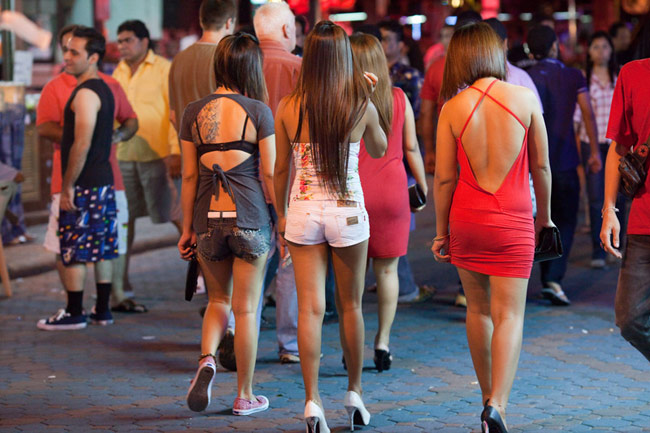
Pretty girls' bums in Pattaya. Canon 5d Mark II, 135mm 1/160th @ F3.5 ISO 5000.
BkkSteve: Technique is everything. Accepting that candid images are often better than posed images, I often find myself taking the liberty of certain shots, and then being mindful of their privacy I'll
show them the image and ask them if its okay to keep it. If they say no, I delete it right there where they can see. This brings big smiles and I think builds trust. Others see you doing it and they get the feeling they can trust you. For me "trust"
has led to more interesting photo opportunities. Sometimes with very rare access. Have you experienced the same?
Stick: Good question… There are a couple of bars where I am allowed to shoot inside the bar. There's no nudity at all and as I have got to know the girls, they have allowed me to shoot inside. There
was one shoot I took which I included recently in a weekly column. It was a close up of a girl in Tilac bar who had folded a US 1 dollar bill into a ring and was wearing it on her finger. I pulled out the camera with the 24 – 70 attached – which
as you know is a sizeable lens – and shot it right there in the bar while all the girls were dancing. No-one blinked when I took the shot.
Had a tourist pulled out a tiny camera in there I can picture the scene now with girls diving for cover and the big beefy mamasan who would scare Sly Stallone coming over to sort him out!
So yeah, that was one time when trust built up was on my side. Of course I could have just gone outside and shot it there.

Pretty girl & dollar bill ring. Canon 5d Mark II, 35mm 1/40th @ F1.6 ISO 6400.
BkkSteve: I must have missed that shot.. I think I was looking at the close up of a woman's stomach.. at least I hope it was a woman.. Inside the bars can be a huge challenge. The only time I've
been able to do with the big cameras was by invitation and the invitation is usually linked to some very strict agreements. Very rare. You probably have much better access. Is there any specific bar you would find more memorable than others to
photograph?
Stick: I have enjoyed shooting in The Strip in Patpong. I know the owners as they advertise with me and I have been given access there to shoot. Again, there's no nudity there so that helps. I shot one
of the woman doing a show with a python and the shots came out well and I was really pleased. I think one point I have to make about shooting in the bar is that I do *not* use a flash.
A flash upsets people and makes you, as the photographer, very visible. Shooting without a flash makes things so much more low key. And the funny thing is, you hear people whispering things like "that idiot isn't using a flash – none of the
shots will come out" Hahaha, if only they knew! (None of the photos here used flash, not one.)

Showgirl with a snake at Patpong. Canon 5d Mark II, 35mm F1.4 @F2 1/60th ISO 5000
BkkSteve: I agree.. using a flash gives an amateurish look to the photos unless done with great skill, and inside a dimly lit bar with different color lights, it takes a lot of skill. Low light photography
without flash is also skill intensive, and requires some very capable equipment. I've heard the same whispers and sometimes it makes me smile. Everyone once in a while someone will be so kind as to tap you on the shoulder and let you know
your flash isn't going off
It's easy to forget that having been here a while and in these venues many times, that we take a certain amount of knowledge for granted. With this in mind, how would you advise an actual tourist who is into photography and wanted to photograph the
nightlife areas, and inside bars?
Stick: For a tourist who wants to photograph inside a venue, it's pretty tough. 98% of venues won't allow them. Secrets in Pattaya is one bar that does allow it but to be honest, the girls there
are not always thrilled at it. They're told to smile and they grin and bear it but I don't think they're too thrilled…
Mmm, this is a difficult question because really some trust needs to be built, rapport established. They might get lucky in a bar but I don't think so. And really, it's not a good idea to surreptitiously take shots because they can get a bit
nasty about that sort of thing…

Very pretty girl in Pattaya. Canon 5d Mark II 35mm 1/60th @ F2.5 ISO 3200
BkkSteve: There's a final lingering question and it's related to a recent column of yours about your investigations. To what extent does photography figure into your investigations and just how
far away can you be and still get the goods on someone?
Stick: Actually, photography is not a big part of the investigations. Most jobs tend to be in gogo bars and are more related to information than actually photographing someone. In the case where a guy requires
proof that she is working, you might try to get a photo of her outside the bar for proof that she is still working…
If I do ever need to do photography with investigations it is almost always at a distance and I us the 135L 2.0 and that works well because it is a very fast lens and very, very sharp.

Hefty freelancer on Beach Road, Pattaya. Canon 5D mark II, 135L, 200 ISO, F2.2 @ 1/1000 second.
BkkSteve: So you're not wearing a lapel camera hidden inside a flower? For some reason I'd always envisioned private investigators as being wired for both sound and video. Has there been any occasions
where taking a picture from a distance blew your cover or otherwise caused issues for you?
Stick: Nope, never had any problems taking photos from a distance on investigations – and surprisingly you don't do that very often. These days people are really after more in-depth information than
a mere photo showing people meeting.

Happy couple off the Pattaya promenade. Canon 5d Mark II, 135mm F2 @F2.5 1/3200 ISO 100.
BkkSteve: We're at the end of the interview and you've shared some good information. Very much appreciated. Before we end this could you please offer your best advice to those wanting to enjoy street
photography in the night life areas? Any advice you think would be most helpful.. Again, thank you for your time and I'll let you have the last word.
Stick: Get a feel for the environment. I guess that's hard for a first-time tourist. As photographers we have been spoiled in Thailand up until recently but now we are suffering a bit of a backlash as
so many people are taking photos and videos and posting them online. We have to be aware of what's going on out there and whether people are concerned at what we're doing. As far as street photography goes, if you're doing it at
night, invest in good lenses. That probably means low aperture lenses. You needn't spend an arm and a leg. The Canon 50 mm 1.8 is less than 4,000 baht, the Nikon equivalent is priced about the same and these are ideal lenses for shooting
in low light. Oh, and make sure you turn the flash off!

Praying for good luck before the shift starts in Pattaya. Canon 5d Mark II 24-70mm 1/120th @ F2.8 ISO 3200.
Review, Imagenomics Portraiture
 I've know Mason Hladun for several years. He's a friend and an extraordinary glamour photographer with an uncanny ability to turn out very unique and I dare say often erotic glamour imagery. With 40 years of photography and 30 years of marketing experience he's worked on four continents and had exposure with many cultures.
I've know Mason Hladun for several years. He's a friend and an extraordinary glamour photographer with an uncanny ability to turn out very unique and I dare say often erotic glamour imagery. With 40 years of photography and 30 years of marketing experience he's worked on four continents and had exposure with many cultures.
He expanded his photographic pursuits to include people and portraiture in 1999, and since can be found in his 'Shattered Glam Studios' providing modeling portfolios, fashion displays, and discrete glamour sets for individuals and couples. Published internationally his portrait and product work can be viewed at: www.shatteredglamstudios.com and www.sysoftcomm.com. I'm thrilled he's now part of our Bangkok Images review team along with Craig Lamson, myself, and Tom Tweedel.
Imagenomic Filters
No body is perfect and that truism is no more apparent than in the world of Glamour photography. In the Glamour world the subject is paramount and more times than not the ideal rather than the real. We want to see an expression of perfection in which
flaws have no place and are not suitable for the audience. I shoot beautiful women, or at least need to make my clients as beautiful as possible.
Mine is hardly a special environment and my workflow is rather simple. I shoot for print, ultimately outputting work in the CMYK color space and use the world of the internet in support of my core needs. I shoot JPEG in the sRGB color space and do so
with a Nikon D-200 which supplies an image suitable for a 12” x 18” which translates to an occasionally needed two page, double truck, spread. I work with images I produce as well as images produced by others to supply my print needs
which manifest themselves in an American page size magazine.
I run an Adobe shop and have done so since the first release of Photoshop. I am currently using the CS4 suite which does an excellent job for me from concept to production. With a common user interface Adobe provides a complete solution for my needs in
all medium necessary. Since the acquisition of Macromedia, now even the familiar features of Flash for motion graphics and Dreamweaver for web development are included under a common feature and data interface.
As you might imagine I am always interested in plug-ins and add-ons to my workflow which will make the final image the best I can produce.
A couple of years ago I became aware of a very special suite of plug-ins from a company called Imagenomic. After an easy install, under my Filters option in Photoshop I am presented with an Imagenomic selection leading to three distinct filters.
Noiseware
Noiseware is a global noise reducer I use mostly for my location work. I particularly enjoy shooting at night and can find noise in the shadow areas of the shot. Noiseware quickly and efficiently removes the noise and miscellaneous artifacts I find in
my digital night shots.
Real Grain
The Real Grain filter is one with perhaps the most deceiving name. Adding grain or digital noise is certainly possible but so is a wide range of toning and tinting. The filter is equipped with a myriad of presets that will surely delight the experienced
film photographer and darkroom process enthusiast. My use is primarily for B&W conversion and process toning. When I have a need for stylizing an image for a particular purpose I am confident that I can find most options within Real Grain
and seldom need to look elsewhere.
Portraiture
Portraiture is the best filter I have found for general skin treatments. I say this without equivocation as I have tried all manner of procedure, action and filter to produce images that delight my clients. At the end of any process undertaken for business
the only thing that matters is whether or not a client will buy. In short, Portraiture helps make money.

As you can see results may be dramatic as well as pleasing
As you probably noted in my early paragraphs, I am a simple photographer and don’t like to over complicate things. More often than not my final product is a 9” x 12” image (4:3 aspect ratio) in the CMYK color space. My camera is set
to fine JPEG in the sRGB color space.
Once transferred to my computer I use Adobe Bridge as my virtual light table and select images for work from there. My first step in Photoshop is to create a work layer upon which I will do my initial fixes using the clone and heal tools.
If I need to do any color balancing or tonal control I will create or import an adjustments layer. The next step is to resolve the aspect ratio differences between the camera’s 35mm format (3:2) and my desired 4:3. A crop decision is required at
this point and if my crop area is smaller than my frame I will use Genuine Fractals to resize the image before making the actual crop.
With these steps completed I have a 9” x 12” image file saved in TIFF format at 300 dpi. It is to this image I will apply the Imagenomic Portraiture filter. I’ve always appreciated the user interface and use the vertical split frame
option showing me a good before and after preview. While the original version of the user interface, still in use in Noiseware Pro and Real Grain, was clean and functional the new one seen in Version 2 of Portraiture is sublime elegance.
Of course all the new features are available but one can literally start at the top and circle clockwise around the preview and complete their setup. This setup “cycle,” in short order, becomes unnecessary because after one selects and becomes
comfortable with a preview scheme, a rendering option, output and masking preferences changes are generally unnecessary.
The preview function offers a full screen and two splits as standard. A user may select a single screen or split comparisons in horizontal or vertical orientation. Bracketing is also available with a host of options for deviation. One may select between
fast and accurate previews which further tune the time the program takes to yield the preview image.
For the studio shooter where environment is controlled and repeatable things become even easier. The highly adjustable variables of Detail Smoothing, Skin Tones Mask and Enhancements may be set and maintained as custom presets which will work with predictable
results. Once the basics of producing a sellable image are established, the time saved may then be used for more interesting artistic expression.
Within the Skin Tones Mask bank of controls two helpful visual aids affect Luminance and Hue. A virtual area map allows for the selection of luminance and has meant to me I can select a finite range of tones correlating with my subject’s skin within
the image. Hue is controlled with a simple slider and further contributes to the selection of skin tones and the effect of the filter upon them.

Before/After
Portraiture offers a set of options within an Enhancement bank where variables such as Sharpness, Softness, Warmth, Tint, Brightness and Contrast may be tweaked in degrees to most anyone’s delight.
As with most things, a little bit may mean a lot and this is certainly the case with Portraiture. I have three basic presets in the Detail Smoothing bank; a little bit, a little less and almost nothing. For the majority of my images my middle setting
will suffice. It is easy to get carried away in the quest for lovely skin but too much of a good thing can lead to a plastic feel without a believable natural look. In the studio setting where ISO’s are low, F-stops moderate and exposure
speeds high some post processors will find the minimal settings amazing.

Lady in Red
A helpful feature in Portraiture is the ability to have effects applied in a new layer. In shots such as the one on the left applying the filter to a new layer leaves open the easy option to erase areas exposing the subtle details and texture of the fabric
contained in the original layer below.
Not unlike the other filters in the suite, Portraiture is complete with a variety of presets which may establish the basis for many photographers’ work. Once tweaked and tuned to an individual’s liking, the recipe may be set as a custom
preset to be used again and again.
In summary, Portraiture is an essential product for people shooters. Through a variety of tools and controls Portraiture provides a photographer a wealth of options of how an image might be presented to a
client. While providing a wide latitude of possibilities, Portraiture may be well tempered to provide a set of predictable results to the studio shooter.
Steve's Comments
Imagenomics Portraiture is a very intensive package and I must admit with other commitments I didn't get nearly the seat time I would have liked to have to fully review this product. Because of this I'm totally deferring to Mason's vast
expertise with this specific product.
I did get in over 20 hours of use and there is no denying this is one of the top products in it's genre available. I've used Imaginenomics competition for years and I'm well versed in it's use, and eventually I want to do a side by
side comparison of most features.
I will continue to use Imagenomics and gain the requisite experience necessary for a meaningful review comparison. I estimate as early as next February we'll publish this comparison.
Thank you Mason for your great review, and thank you to Imagenomics for their support duringt his process.
Steve
Photography News of Interest
Who can forget Al Gore's claim that he invented the internet? How about the guy who invented the digital camera? Steve Sasson (sic) is credited with inventing the first digital camera
and was recently awarded an honorary doctorate from the University of Rochester. You can read about this small but significant piece of digital historyhere.
More and more I'm becoming a big fan of small pocket cameras, mainly because I can almost always have one available when an unexpected photographic opportunity comes my way. These small pocket cameras are becoming more capable every year. Over at
the Luminous Landscape they test three different small cameras which have an appeal to DSLR shooters in common. The Canon Powershot G10, Canon Powershot G11, Sigma DP1, Panasonic Lumix GF-1, and the Olympus EP-1 are talked about and some of them compared in this excellent article. Give it a readhere.
Last week I shared with you Adobes release of Lightroom 3 Beta, and that it's a free beta, no license required. The folks
at Luminous Landscape take you on a first-look first-drive tour of the new Lightroom 3 and I find it informative. Take a look here.
Windows 7 is here! What does it offer and should you purchase a copy or two? Currently there are many articles out discussing these very issues but I find this one particularly useful.
They make fair comparisons, perform useful tests, and make solid useful recommendations. You can read it here.
Phase One releases its latest version of its excellent Capture One Pro, Version 5. This is arguably the best professional raw converter
out there, in the sense that it makes the best conversions. I've been using it going on 7-8 years now. You can get the latest versionhere.
Carl Zeiss has been slowly rolling out some of their best lenses armed with the Canon EF mount and the 35mm F2 version is their latest. This lens competes directly against Canon's
own 35mm F1.4L prime lens and at hundreds of dollars less! Read about ithere.
Readers' Submissions
Steve,
Quick trip the the US from Thailand for the daughter's wedding allowed a free day in Gettysburg to ride and walk around the historic Civil War battle field. We had a beautiful fall day where the air was crisp, the sky blue and the leaves
very colorful. We took this opportunity to take a few pictures of and on the battle field and I have to say, being outside where it was bright was considerably easier than the previous day during the wedding.
The pictures I'm sending to you here are just to give you a conceptual idea idea of the battle field, a reminder of how beautiful the fall foliage here in Pennsylvania at this time of year can be, and an update on the very slow progress being made
with my skill in using the DSLR camera. The shots you see here are with both my Canon DSLR and 1 or 2 of the pics is with a point and shoot Sony.

An old restored building in Gettysburg town… probably the train station.

Picture Gettysburg Battlefield, 20 Oct 2009: a restored fence line as used during the Civil War.

Picture House on Gettysburg Battlefield, 20 Oct 2009: stone house on that battle field that has been restored and in use.

View of Gettysburg battlefield from Devils Den, 20 Oct 2009: This is a view North from Little Round Top the Civil War battlefield. Little Round Top is where the Union officers
observed and directed the battle field from.

View South from the battle field to Little Round Top.

View South from the battle field to Little Round Top.

View South from the battle field to Little Round Top.

View South from the battle field to Little Round Top.
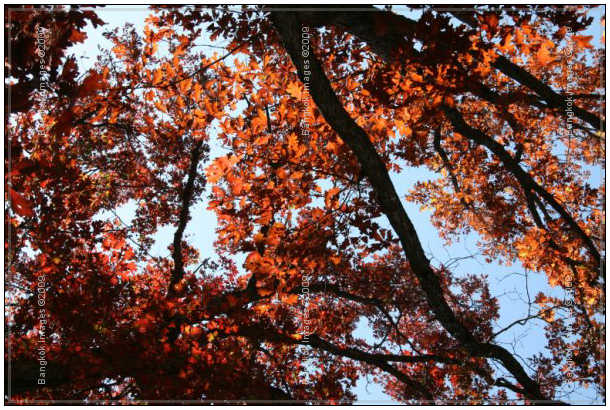
Fall foliage colors on the battle field.
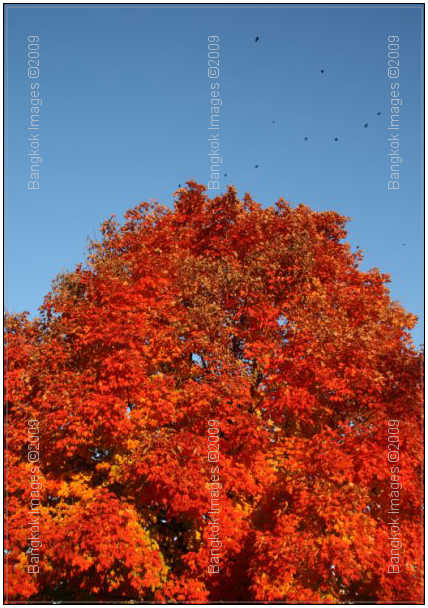
Fall foliage colors on the battle field.
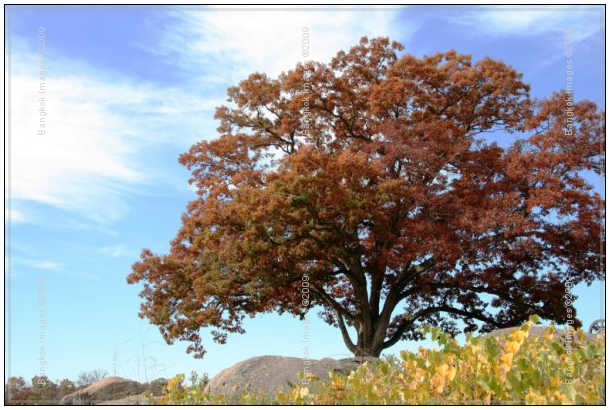
Fall foliage colors on the battle field.
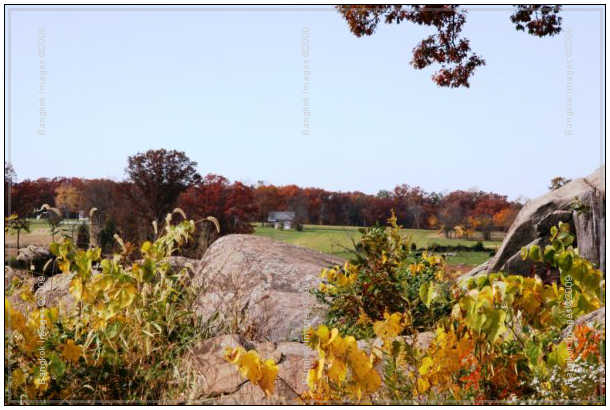
The battle field.
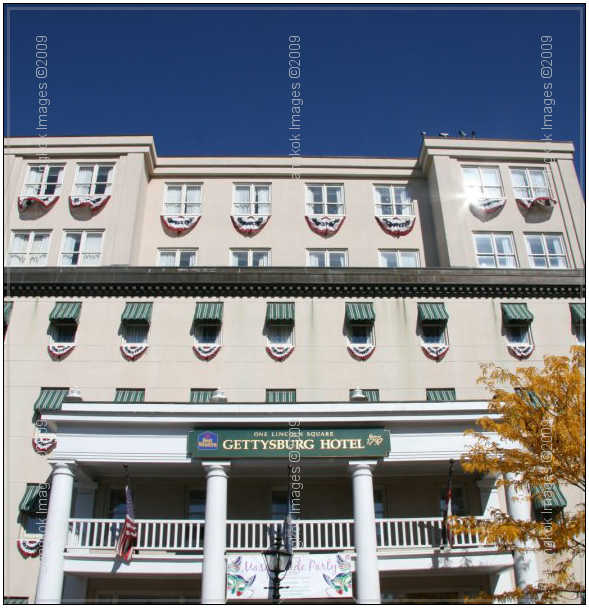
Gettysburg Hotel… restored. This is where the daughter's wedding reception was held. It cost a pretty penny…..
MTS International
MTS –
I'm really enjoying the images from your travels! You're developing quite the eye. The fall colors are timely. 🙂
Steve
I suspect the readers submissions will be a highly anticipated section of this column and I encourage anyone with photographs and travel accounts they'd like to share to please send them to me at: QandA@Bkkimages.com
Readers' Questions
BkkSteve ;
The last few years you've shared images from Loy Krathong. Each year it appears you used different techniques. I'm going out on Loy Krathong this year and I would very much enjoy impressing my girl friend (and justifying my expensive hobby)
by turning out some high quality photos. Can you give me some pointers?
Zifprint
Zifprint –
Loy Krathong is my favorite Thai holiday. Festivities run the gamut from children's beauty pageants to loud roaring parties to individual reflection and meditation. The venues are even more varied. What this means is it's impossible to guess
what you're going to run up against with the exception of one factor. It's going to be darker than dark.
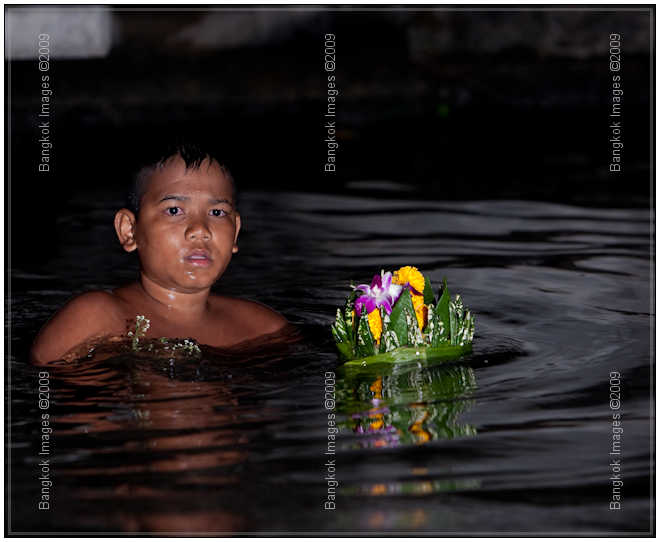
Canon 1ds Mark II, 70-200mm F2.8 IS @F4 1/125th ISO 400 Quantum Strobe
This means you'll need to make the decision to shoot at uber high ISOs (ISO 6400++) if you have a new DSLR with that kind of range, and you'll still need uber fast glass (F2 or lower) to match
it. OR, you'll need to light your subjects in some way and this can get very tricky. The advantages of artificially lighting your subjects is that you can shoot at more reasonable ISOs and achieve much better image quality.
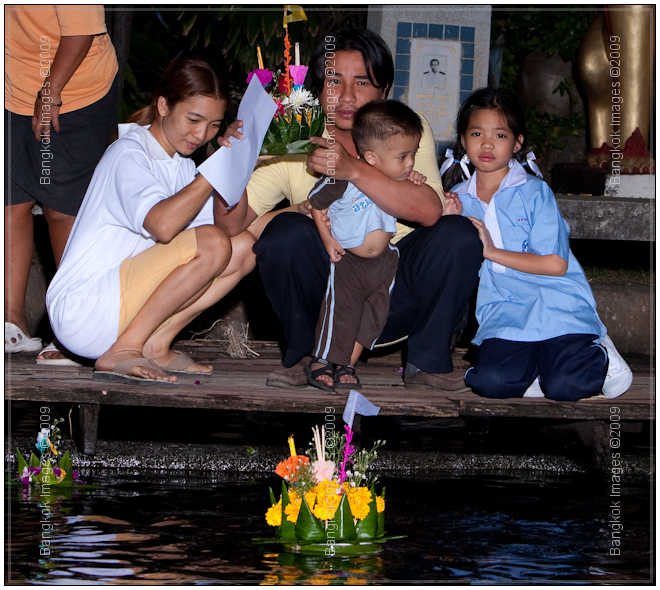
Canon 1ds Mark II, 70-200mm F2.8 IS @F8 1/125th ISO 400 Quantum Strobe
I've shot Loy Krathong both ways, and some interesting variations. Over the years I've learned that a very high quality directional off-camera strobe outfit allows the most flexibility and highest image quality. The tradeoff is that it takes
a fair amount of skill to pull off without the "deer in the headlights" look, and it also requires an assistant to function as a walking light stand.
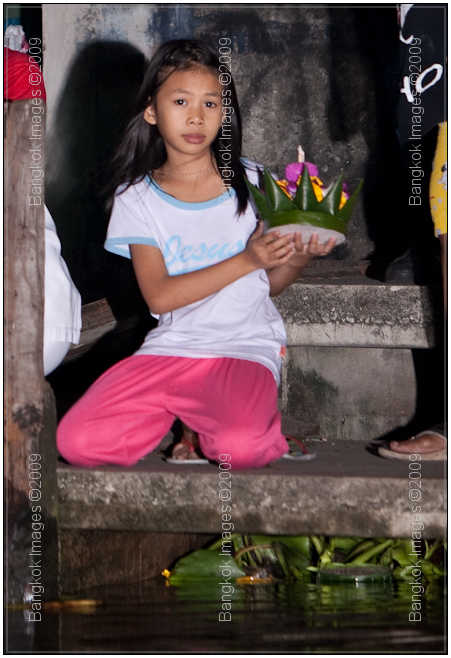
Canon 1ds Mark II, 70-200mm F2.8 IS @F4 1/125th ISO 400 Quantum Strobe
This is currently my favorite method, but I wouldn't hesitate to use a high ISO body and fast lens to keep things simple with faster handling. I was out there last night making my own captures. Did you see a sampan with a several farang/Thai couples
out on the On-nut klong with a big strobe and an even bigger lens?
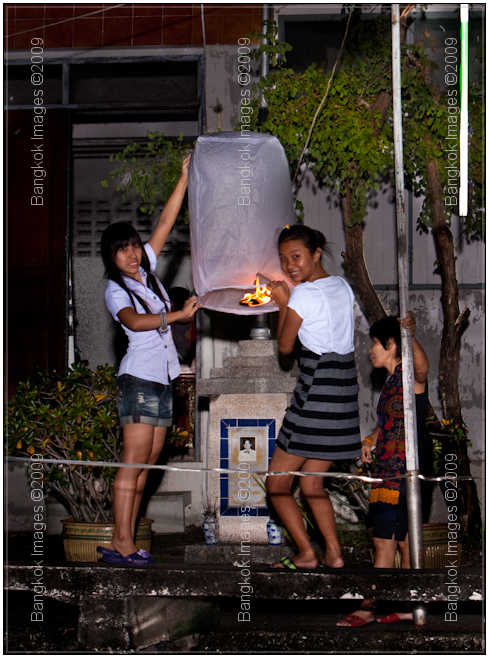
Canon 1ds Mark II, 70-200mm F2.8 IS @F5.6 1/125th ISO 400 Quantum Strobe
I hope this helps. Good luck out there!
Steve
Please submit your questions to QandA@Bkkimages.com All questions will be answered and most will show up in the weekly column.
A Snapshot of Bangkok Images Week in Review
This was a busy week. Two workshop days and four print orders from weddings shot over 6 years ago. We've also been putting a lot of time into finding the perfect print display devices. Simple frames won't work for me because I'd like to
put up new prints after every shoot to keep things fresh and current.
By the time you read this I'll be back in Mae Sot. I feel there is so much material here which isn't reaching the mainstream. Access is an issue, but persistence will win over. I'm not sure if I'll be done here in Mae Sot in time to
put out a November 15th issue. We have some great reviews coming soon, a trip report from Dr. P from Africa, and a few more interviews. It's just that putting this column together takes a great amount of time and a proper workstation. If
I can't manage to get something together by the 15th, perhaps the next week.
A last minute schedule change as this goes to editing. Mae Sot will have to wait until the following week. Time constraints with a personal project prevents a trip of this distance. Instead, by the time you read this I'll be exploring some unknown
southern beach instead.
Infocus Blog
Image Management
This isn't what you think it is. It's different. Like many other professions photography requires continued education. This comes in many forms from surfing the web for the latest news, to workshops featuring the latest products/techniques,
to a reading list. On my desk sits no less than 20 volumes on photography waiting for me to have the time to read. And this isn't light reading like the latest Tom Clancy adventure novel, this is the sort of reading you need to think about
and perhaps even experiment with.
The book I was reading today was Ansel Adam's "The Camera." I have a strong interest in obtaining an 8×10 inch view camera sometime in the future. An 8×10 negative is truly a thing of beauty.
This is an excellent book for explaining and comparing the features and capabilities of these types of cameras. More, it talks about why you would use each type of camera as it pertains to the 'image'. And there's a section that
talks about "image management."
Image management is about being able to isolate the essential elements of the image and manage them for the best effect. The book goes on to talk about these elements and my mind locked on one of these elements like a heat sinking missile up the tail
of a F-14 on afterburners. The element is "the essence of the image."
This isn't about focus, or sharpness, or depth of field, or noise or any sort of 'technical' feature concerning image quality, and it's not about the rule of thirds and the other parts of a solid composition. It's about the essence.
That one thing you want the viewer of this image to notice above every other part of the image. It's the message, the reason you pointed the camera, the soul.. Do you think about these things when you take a photograph? Perhaps not conscientiously,
but maybe sub-conscientiously?
I think if we self-imposed a requirement on ourselves that we'd only release the shutter when we were capturing "the essence" as we'd thought it out.. we'd take precious few photographs. However, I'd bet they'd be damn
good ones!
So.. I was thinking.. how I could isolate "the essence" of a sample photograph to share with you what I was thinking when I made the capture. I scanned some negatives, used Photoshop to make outlines,
and tried all sorts of things.. but none of them seemed effective. And then I made this image.

Canon 1ds Mark II, 300mm F2.8 IS F4 1/4000th ISO 100
Stripped of all image quality features of sharpness and clarity, yet with the bare minimum of features to show the essence. Excuse me if I'm just being nuts here which is entirely possible. As far as I know no one as ever done this before..
What do you see in this image, what was "the essence" I was trying to show. I've shown this image to a few dozen people and most seemed to like it for various reasons ranging from it's
animated look to a youthful appeal. Only one person saw the sadness in his face and posture. His eyes and mouth and slumping shoulders are showing the essence of this image. The element I wanted to share with the viewer above all else.

Canon 1ds Mark II, 135mm F2 @F2.8 1/40th ISO 400
What about this one? Once again I stripped out any image quality factors and left only the essence.. the feeling. This is/was an environmental portrait. A professional at work, doing what she was born to do. Doing what she loves. Look at the eyes. They're
not detailed, but you can't miss the focus and direction. The upright posture of someone supremely confident in their abilities. The body language speaks loudly. She's in her element, totally confident and comfortable, and she loves
what she's doing. Would it help to know she's a conductor rehearsing before a concert?
Image management. The management of the essential elements within an image. The "essence" of every image we capture should be known before we effect the capture, so we can use the other elements
of the image to support the essence. Image management. It was a very worthwhile lesson.
Until next time..



